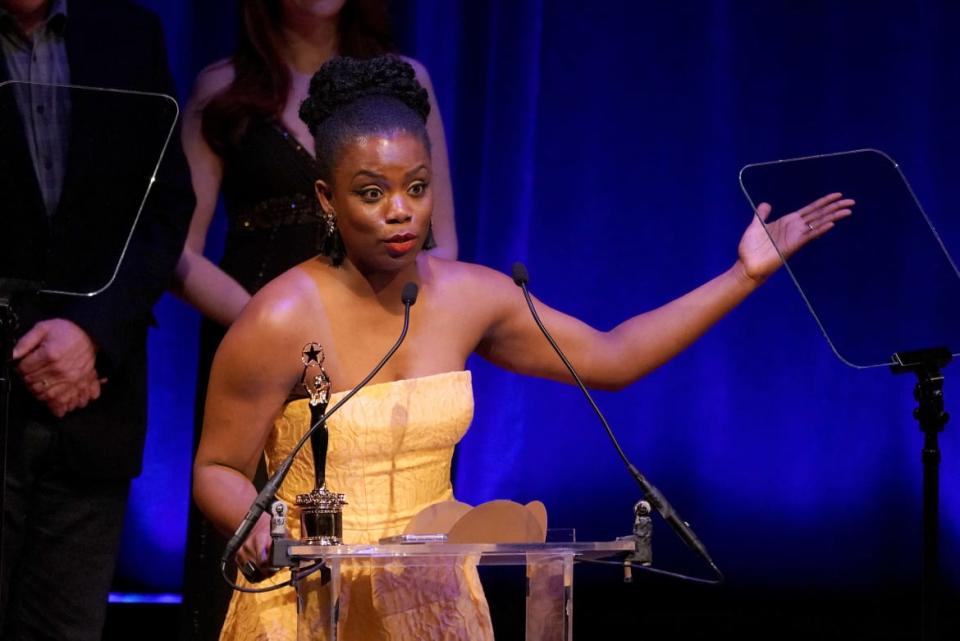How Hollywood Can Better Protect Black Viewers’ Mental Health

- Oops!Something went wrong.Please try again later.
“I wish I could just say, ‘Well, it’s fantasy,’ and move on. But I can’t.” Elisa Sjunneson-Henry wrote those words in an essay for Tor.com in 2018, about her struggle, as someone who lives with disabilities, with seeing disabled people portrayed solely with able-bodied partners in science-fiction media. For Sjunneson-Henry and other disabled viewers, these depictions, like in the Oscar-winning movie The Shape of Water, meant being forced to watch their disabilities as being viewed in a lesser light compared to able-bodied counterparts. Too often, like in Me Before You and Full Metal Jacket, these characters would end up hurt or dead, unable to enjoy a happy ending.
Although disability and race are vastly different, I feel the same way when I watch other movies, TV shows, or plays where a Black person (if not multiple Black people) die. I wish I could say, “It’s just fiction,” and move on. But I can’t.
When Poussey, a Black lesbian character in Netflix’s Orange is the New Black, was killed by a correctional officer in prison in Season 4, I had to grieve. My heart hurt and I cried for three days, even for a character who did not exist. Simultaneously, I thought that Poussey’s death on screen would be a teaching tool for people to recognize the grief we feel for Black people in real life who die, and hopefully combat systemic killings like hers.
End the Stigma on Black Men Suffering From Depression
I was wrong. Black people are still gratuitously killed off in entertainment media all the time. It’s almost a gross mirroring of what continues to happen in real life as well—Philando Castile was murdered by law enforcement on July 6, 2016, less than a month after Poussey’s death in OINTB.
As a Black consumer, I cannot be the only one experiencing fatigue seeing Black people die in movies and television repeatedly. I even see this happen again and again in content that doesn’t focus on police brutality, prison, or slavery. Just this summer, sci-fi and fantasy films and shows like Doctor Strange in the Multiverse of Madness, Umbrella Academy, Stranger Things, and The Sandman all featured scenes where multiple Black people are the first or among the first characters to be killed.
Making matters worse is that while Black people are more likely to die on screen, they are the racial demographic least likely to be depicted navigating successfully through mental health and suicidal ideation.
Research shows that Black people report worsened mental health in the aftermath of increased news media coverage of Black people who die by police brutality. Suicide rates are rising among Black youth, and Black activists have even died by suicide amid an increased awareness of anti-Black violence and death.
For his 2019 master’s thesis at the University of Southern Mississippi, criminal justice researcher Blake Edwards explored how film and television portrayals of Black individuals committing crimes affects the larger public’s perception of Black people, especially when viewers are exposed to those images over and over again. Edwards’ showed that Black people were more likely to be portrayed as living in poorer living conditions, or as antagonists to typically white protagonists. Many shows and movies misinterpreted vicious stereotypes (like Get Hard and Menace II Society) as liberation for Black people. As a result of these transgressions, viewers were more likely to perceive Black people as responsible for their own oppression.
Ultimately, there’s an identifiable crisis at play here. So why isn’t there more research on how the mental health of Black people correlates with entertainment media, and what can we do to remediate the negative impacts?
It might be easy to simply say “it’s just fiction, move on.” But fiction works to encapsulate the human experience—and it can have lasting effects based on how it does so. The Birth of a Nation, the infamous 1915 film supported by Southern white supremacists, was fiction, and it still encouraged racist rhetoric and tropes that are still alive and well. One hundred years later, Orange is the New Black, also a work of fiction, did not erase the reality of Black people who undeservedly die. “It’s just fiction, move on” is a way to allow harm to continue without consequence—and it negates the role media and pop culture can play in ingraining society with better values.
Many universities and colleges also simply ignore this type of research and refrain from supporting it robustly. When scholars are afforded opportunities to look into how onscreen portrayal of Black death affects Black mental health, it is often relegated to niche fields like “Black studies” or “film studies.”
End the Stigma on Black Men Suffering From Depression
Even as mental health is being taken seriously as a facet of public health, there continues to be a is a lack of support from public health foundations such as the National Institute on Minority Health, Mental Health America, The Centers for Disease Control and Prevention (CDC), and The American Foundation for Suicide Prevention. These parties have supported news media and entertainment media specific studies before; yet they have chosen not to fund fresh new studies exploring the effects of media on Black mental health, and what kinds of solutions we ought to implement.
And of course, the lack of institutional support is bolstered by an apathy from the general public—specifically white viewers who may not experience the same emotional dysregulation when seeing Black characters die on screen the same way Black viewers would. White viewers may argue that white people die on screen too, and they’re right. But it’s also true that white characters more often live happily ever after and the end and black characters don’t.
It’s not as if the Black community isn’t already voicing its desire for better movies and shows. Black consumers have openly expressed their desire for more joy so we’re not pigeonholed in one type of story; especially a story of violence that repeats to the point of fetishizing Black pain through death.
Although Hollywood has professed a desire to incorporate more Black creators in the writers’ room in order to more authentically capture the Black experience, simply tasking Black writers to write Black death is no solution. The same fatigue that plagues Black viewers can also affect the mental and emotional health of Black creators as well.
Antoinette Nwandu both confronts and subverts this issue in her recent play, Pass Over: a modern retelling of Waiting for Godot that features two Black men, Moses and Kitch waiting at a lamp post to leave (or “pass over”) their hard lives in their neighborhood. Moses and Kitch never get to leave once Moses is murdered by a white character named Mister; the same white actor who plays the cop who harrasses them in the play, Ossifer.
Nwandu’s original ending does end with a Black death—something she grieves over, even as a writer. The ending does, however, undercut the death-by-cop trope that befalls so many Black characters in entertainment media. After all, there’s a necessary merit to exploring Black pain and in Black storytellers using art to unpack how deaths in our community affect us.

Antoinette Nwandu accepts the award for Outstanding Play on behalf of “Pass Over” onstage at the 34th Annual Lucille Lortel Awards on May 5, 2019, in New York City.
And since then, Nwandu has rewritten Pass Over with three different endings—one including a death and the other two joyful where no one dies—in order to encourage healing and encourage playmakers to choose the ending that their community needs most. This kind of creativity not only pushes the boundaries of cultural and entertainment media into something more daring; it also provides space and flexibility to meet the audience where they are.
The most daring entertainment is one that does not rely on tropes that cause harm. As consumers, we can’t look away from how being exposed to that harm affects us and the identities we hold. Even when it’s fiction. The solution isn’t turning off our screens; it’s to advocate for healthy creations of films, shows, and plays that are better to watch with more Black people safe and alive.
Get the Daily Beast's biggest scoops and scandals delivered right to your inbox. Sign up now.
Stay informed and gain unlimited access to the Daily Beast's unmatched reporting. Subscribe now.

